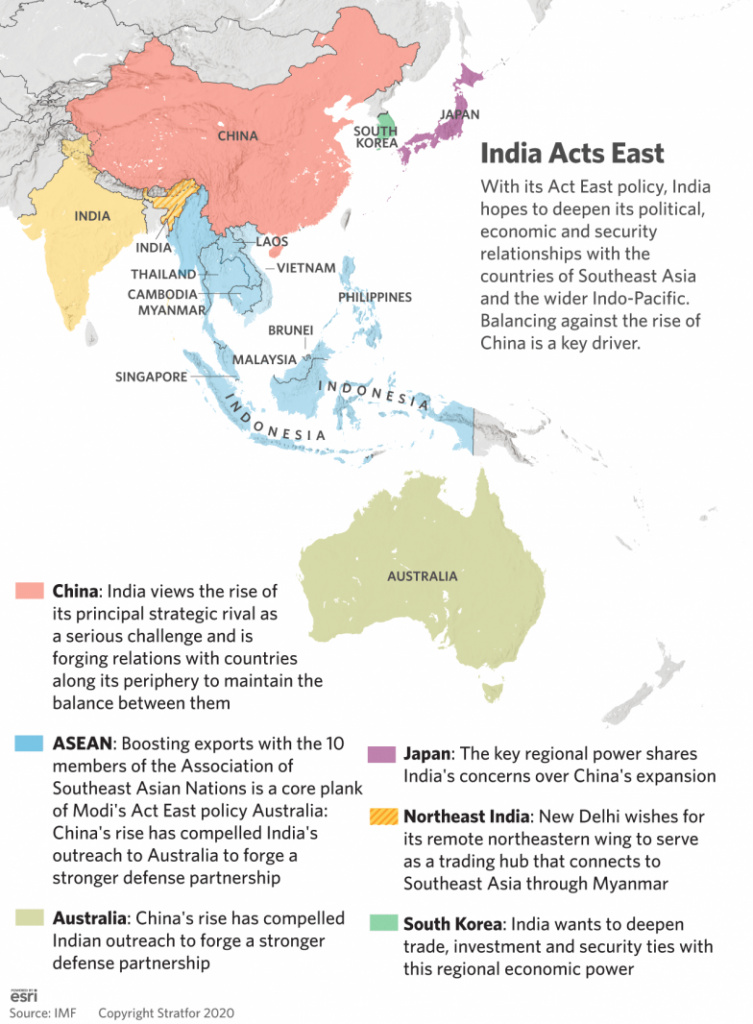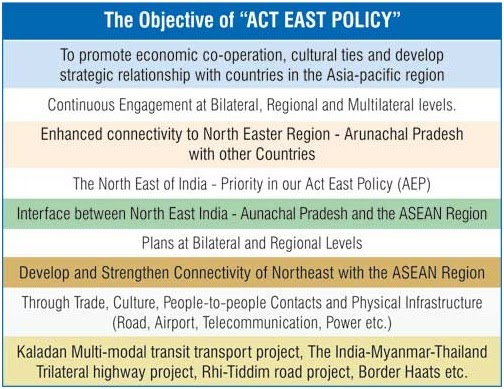Relevance: Mains: G.S paper II: Polity: International
Context
- India’s Act East policy was initiated 30 years ago as “Look East” policy to cultivate strong economic and strategic ties with the South East Asian countries. In 2014, the Modi government renamed it to the more dynamic sounding “Act East”.
Look East Policy
- India’s Look East policy is a diplomatic effort to cultivate extensive economic and strategic relations with the nations of Southeast Asia to bolster its standing as a regional power and a counterweight to the strategic influence of the People’s Republic of China.
- Initiated in 1991, it marked a strategic shift in India’s perspective of the world.
- It was developed and enacted during the government of Prime Minister Narsimha Rao and rigorously pursued by the successive administrations of Atal Bihari Vajpayee and Manmohan Singh.
- The success of Look East policy enthused the mandarins of South-Block to develop the policy into a more action-oriented, project and outcome-based policy.
- After a couple of decades, India’s Act-East Policy, which was announced in 2014 by Prime Minister Narendra Modi’s administration, became a successor to the Look-East Policy.
Act East Policy
- India’s Act East Policy focusses on India’s extended neighbourhood in the Asia-Pacific region.
- The policy which was originally conceived as an economic initiative, has gained political, strategic and cultural dimensions including the establishment of institutional mechanisms for dialogue and cooperation.
- Act East Policy has placed emphasis on India-ASEAN cooperation in our domestic agenda on infrastructure, manufacturing, trade, skills, urban renewal, smart cities, Make in India and other initiatives.
- Connectivity projects, cooperation in space, S&T and people-to-people exchanges could become a springboard for regional integration and prosperity.
- The Objective of ”Act East Policy” is to promote economic cooperation, cultural ties and develop strategic relationship with countries in the Asia-Pacific region through continuous engagement at bilateral, regional and multilateral levels thereby providing enhanced connectivity to the States of North Eastern Region including Arunanchal Pradesh with other countries in our neighbourhood.
- The North East of India has been a priority in our Act East Policy (AEP).
- AEP provides an interface between North East India including the state of Arunachal Pradesh and the ASEAN region.
- Various plans at bilateral and regional levels include steady efforts to develop and strengthen connectivity of North East with the ASEAN region through trade, culture, people-to-people contacts and physical infrastructure (road, airport, telecommunication, power, etc.). Some of the major projects include – the Kaladan Multi-modal Transit Transport Project, the India-Myanmar-Thailand Trilateral Highway Project, Rhi-Tiddim Road Project, Border Haats, etc.
Concerns about foreign investments
- Suddenly, every major power seems to be interested in the “potential” of the North Eastern Region (NER).
- Japan has shown interest in investing in various infrastructure projects in India through various agencies, particularly the Japan International Cooperation Agency (JICA).
- One can’t help but wonder if this is to counter the Belt and Road Initiative of the Chinese government, an ambitious project to build a new “Silk Road,” which will allow the Chinese to control lucrative trade routes as well as important connectivity infrastructure all over Asia and Africa.
- There are now geriatric care service providers in Assam, where the language of instruction is Japanese, and non-governmental organisations are scrambling to create “investment opportunities” for Laotian and Thai businessmen.
- These are not necessarily bad developments, but it will do us good to pause and think about how these activities might affect us.
- The fact that a lot of this development is inorganic (and not homegrown) remains a cause for concern.
The consequence of foreign investments
- The money that foreign countries and their development agencies are “giving” us comes with conditions.
- It is a loan, and loans always need to be repaid with heavy interest and in some case, the interest might be more than just monetary.
- One of the very real consequences of these changes is that with this new money coming in (and it is big money to the tune of billions of dollars), corruption and inequality in the region are set to take off on an unprecedented scale.
- Government leaders will have to ensure that their financial backers are happy, meaning that contracts will need to be signed in favour of certain people, resulting in the concentration of more wealth in fewer hands.
Conclusion
- Though it is true that the past year has seen a flurry of activities, all in all, it seems to hold nothing significant for the people of the North East, especially the rural poor.
- The infrastructure and the techno-structure that the Act East policy seeks to install are problematic.
- The economic and job promises are great if they come true, but should we sacrifice long-term goals for short-term gains? It is a question of how much control we are willing to give up for prosperity and wealth.



